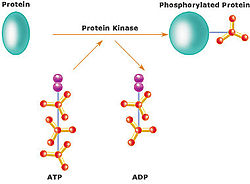Cell signalling is an intricate process which is vital to allow cells to function. Signalling occurs in dynamic, rapidly reversible cascades, most of which involve phosphorylation. Phosphorylation is the most common mechanism by which cells regulate protein function and transmit intracellular signals. This is achieved by proteins known as Kinases.
Kinases
- Mediate phosphorylation of proteins
- Creating a signal cascade that plays a critical roles in the regulation of many cellular processes including growth, apoptosis and signal transduction pathways.
- The human genome encodes for over 500 kinases, misregulation of phosphorylation is a primary cause of many cancers and other diseases.
Steve Smerdon from the National Institute for Medical Research visited Bangor University to speak about the importance of phospho-dependent interactions in structural biology.
The Smerdon group research a number of adapter and scaffold proteins including; 14-3-3, Breast Cancer Gene 1 (BRCA1), Nijmegen-breakage syndrome protein 1 (Ns1b) and many others.
These adapter and scaffold proteins function as platforms that allow the formation of multi-protein complexes via the activities of protein modules such as Forkhead-associated (FHA), Brca1 C-terminal (BRCT)-repeat and the polo-box. These protein modules are activated after phosphorylation by kinases.
MRN compex
- composed of Mre11-Rad50-Nbs1
- at sites of DNA double strand breaks, this complex acts as a bridge to bring both strands together and promote end rejoining.
- referred to as the ‘molecular computer’ as it is involved in many processes including; End-recognition, tethering, resection and checkpoint signalling.
These proteins are of interest as they are regulated by kinases, and therefore play a crucial role in the DNA damage response.
These proteins all interact in a complex and extensive web of molecular interactions, by understanding more about these processes and why they run amok, drugs can be designed to specifically target and combat the disastrous effects associated with cancer and other diseases.
It is clear that phosphorylation plays a vital role inside cells. With research teams like the Smerdon group discovering the in depth detail of the structural biological mechanisms behind these phospho-dependent interactions, we move towards a future filled with a higher comprehensivenss into how cells work. This will hopefully correlate to an increase in our arsenal of drugs in the war against cancer and other diseases.
Papers:
A supramodular FHA/BRCT-repeat architecture mediates Nbs1 adaptor function in response to DNA damage
The BRCT domain is a phospho-protein binding domain





